
BNSF Railway is the largest freight railroad in the United States. One of six North American Class I railroads, BNSF has 36,000 employees, 33,400 miles (53,800 km) of track in 28 states, and over 8,000 locomotives. It has three transcontinental routes that provide rail connections between the western and eastern United States. BNSF trains traveled over 169 million miles in 2010, more than any other North American railroad.

The Grand Trunk Western Railroad Company was an American subsidiary of the Grand Trunk Railway, later of the Canadian National Railway operating in Michigan, Illinois, Indiana, and Ohio. Since a corporate restructuring in 1971, the railroad has been under CN's subsidiary holding company, the Grand Trunk Corporation. Grand Trunk Western's routes are part of CN's Michigan Division. Its primary mainline between Chicago and Port Huron, Michigan serves as a connection between railroad interchanges in Chicago and rail lines in eastern Canada and the Northeastern United States. The railroad's extensive trackage in Detroit and across southern Michigan has made it an essential link for the automotive industry as a hauler of parts and automobiles from manufacturing plants.

Illinois Route 19 is a major east–west arterial state highway in northeastern Illinois, United States. It runs from Illinois Route 25 in Elgin, to Lake Shore Drive on the north side of Chicago. Illinois 19 is 33.64 miles (54.14 km) long. For much of its length, it is also known as Irving Park Road and Chicago-Elgin Road.
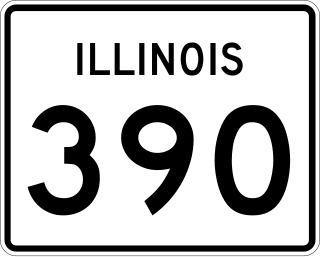
Illinois Route 390 (IL 390), previously known as the Elgin–O'Hare Expressway, now known as the Elgin–O'Hare Tollway, is a 9.8-mile (15.8 km) controlled-access toll road in northeastern Illinois. IL 390 currently connects U.S. Route 20 in Hanover Park to the interchange with Illinois Route 83 and Thorndale Avenue in Wood Dale. The only other towns it borders are Schaumburg and Roselle. Construction is underway to extend the road from IL 83 to the western edge of O'Hare International Airport.
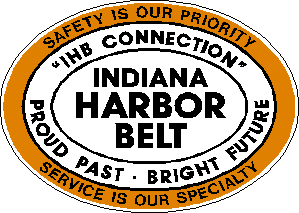
The Indiana Harbor Belt Railroad is a Class III railroad in the United States.

The Belt Railway Company of Chicago, headquartered in Bedford Park, Illinois, is the largest switching terminal railroad in the United States. It is co-owned by six Class I railroads — BNSF, Canadian National, CPKC, CSX, Norfolk Southern and Union Pacific — each of which uses the switching and interchange facilities of the BRC. Owner lines and other railroads bring their trains to the Belt Railway to be separated, classified, and re-blocked into new trains for departure. The BRC also provides rail terminal services to approximately 100 local manufacturing industries. The company employs about 440 people, including its own police force.

The Milwaukee District North Line (MD-N) is a Metra commuter rail line in Chicago, Illinois and its northern suburbs, running from Union Station to Fox Lake. Although Metra does not refer to any of its lines by color, the timetable accents for the Milwaukee District North line are pale "Hiawatha Orange" in honor of the Milwaukee Road's Hiawatha passenger trains.
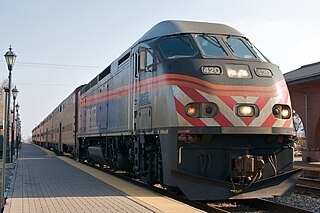
The Milwaukee District West Line (MD-W) is a Metra commuter rail line in Chicago, Illinois, and its western suburbs. Metra does not refer to any of its lines by a particular color, but the timetable accents for the Milwaukee District West line are dark "Arrow Yellow," honoring the Milwaukee Road's Arrow passenger train. Trains are dispatched from the Canadian Pacific Kansas City Railway's American headquarters in Minneapolis.
The Indiana Rail Road is a United States Class II railroad, originally operating over former Illinois Central Railroad trackage from Newton, Illinois, to Indianapolis, Indiana, a distance of 155 miles (249 km). This line, now known as the Indiana Rail Road's Indianapolis Subdivision, comprises most of the former IC/ICG line from Indianapolis to Effingham, Illinois; Illinois Central successor Canadian National Railway retains the portion from Newton to Effingham. INRD also owns a former Milwaukee Road line from Terre Haute, Indiana, to Burns City, Indiana, with trackage rights extending to Chicago, Illinois. INRD no longer serves Louisville, Kentucky, and the Port of Indiana on the Ohio River at Jeffersonville, Indiana, through a haulage agreement with the Louisville & Indiana Railroad (LIRC).
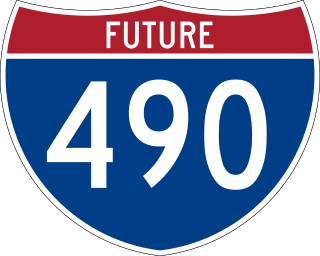
Interstate 490 (I-490), also known as O'Hare West Bypass and Western O'Hare Beltway, is an electronic toll highway and a beltway that is currently under construction near Chicago, Illinois; it will run along the west side of O'Hare International Airport. The tollway will connect I-294 to a western access point to the airport. From there, it will continue northward to an extension of Illinois Route 390 and I-90. The O'Hare Western Bypass is part of the Elgin–O'Hare Western Access (EOWA) project. Building the highway will affect the villages of Elk Grove Village, Wood Dale, Itasca, and Bensenville. The route will run through the 1979 American Airlines Flight 191 crash site, the deadliest aviation accident in US history.
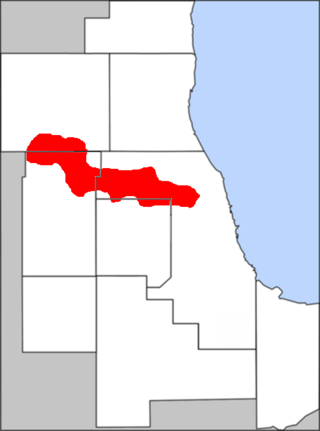
The Golden Corridor is the area around the Jane Addams Memorial Tollway, formerly known as the Northwest Tollway, in the Chicago metropolitan area. Its name refers to the "gold" mine of economic profit for communities in the area. Several Fortune 500 company headquarters, office parks, industrial parks, exhibition and entertainment centers, medical facilities, hotels, shopping centers, and restaurants are in the Golden Corridor. With the exception of the O'Hare area of Chicago, all the communities in this region are part of a larger region known as the "Northwest Suburbs".
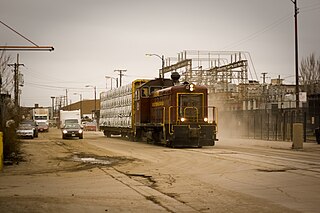
The Chicago Terminal Railroad was a switching and terminal railroad that operated over former Milwaukee Road/Canadian Pacific and Chicago and North Western/Union Pacific trackage in northern Illinois. The railroad began its operations on January 2, 2007. The railroad rostered a total of three locomotive units, all of EMD design.

Franklin Park is one of two stations on Metra's Milwaukee District West Line in Franklin Park, Illinois. The station is 13.2 miles (21.2 km) away from Chicago Union Station, the eastern terminus of the line. In Metra's zone-based fare system, Franklin Park is in zone 2. As of 2018, Franklin Park is the 123rd busiest of Metra's 236 non-downtown stations, with an average of 392 weekday boardings.

Mannheim is a station on Metra's Milwaukee District West Line in Franklin Park, Illinois that gets services during rush hour as a flag stop. The station is 14.0 miles (22.5 km) away from Chicago Union Station, the eastern terminus of the line. In Metra's zone-based fare system, Mannheim is in zone 2. As of 2018, Mannheim is the 218th busiest of Metra's 236 non-downtown stations, with an average of 35 weekday boardings. The reason this station is named because of Mannheim Road running right next to it. It is the only non-ADA-accessible station on the Milwaukee District West Line. The Tri-State Tollway also runs adjacent to the Mannheim station.

Bensenville is a station on Metra's Milwaukee District West Line in Bensenville, Illinois. The station is 17.2 miles (27.7 km) away from Chicago Union Station, the eastern terminus of the line. In Metra's zone-based fare system, Bensenville is in zone 3. As of 2018, Bensenville is the 115th busiest of Metra's 236 non-downtown stations, with an average of 414 weekday boardings.

Mannheim Road, also known as La Grange Road from Cermak Road to U.S. Route 30, is a north–south major street in the near-western suburbs of Chicago. It carries US 12 from Des Plaines to 95th St near Hickory Hills, US 45 between Des Plaines on southwards past Frankfort, Illinois and carries US 20 between Lake Street in Stone Park, Illinois and 95th St. near Hickory Hills.
The Midway Subdivision or Midway Sub is a 12.4-mile (20.0 km) railway line in Minneapolis and Saint Paul, Minnesota. The line is part of BNSF Railway's Northern Transcon which runs from Chicago, Illinois to Seattle, Washington and Portland, Oregon. This is former Great Northern Railway trackage, and now forms the southern set of BNSF tracks running through the Twin Cities. The companion route running slightly to the north is the St. Paul Subdivision, former Northern Pacific Railway tracks. The Midway Subdivision hosts about 24 trains per day as of September 2015.
Barstow Yard is a classification yard operated by Burlington Northern Santa Fe Railway (BNSF) in Barstow, California. With 48 directional tracks and a total area of approximately 600 acres (240 ha), it is the second largest classification yard west of the Rocky Mountains after the JR Davis Yard. Today, almost all freight traffic to and from Southern California runs through the junction.

Canadian Pacific Kansas City Limited, doing business as CPKC, is a Class I railroad in North America that resulted from the merger of Canadian Pacific Railway (CP) and Kansas City Southern (KCS) on April 14, 2023. It is the first and currently the only single-line railway connecting Canada, Mexico, and the United States, operating approximately 32,000 kilometres (20,000 mi) of rail across the three countries. CPKC is headquartered in Calgary and led by Keith Creel as President and CEO.




















